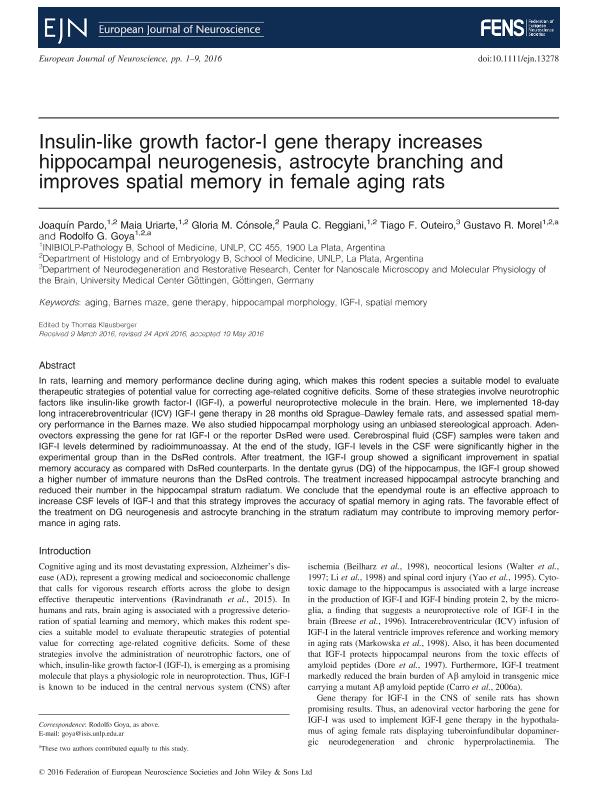Artículo
Insulin-like growth factor-I gene therapy increases hippocampal neurogenesis, astrocyte branching and improves spatial memory in female aging rats
Pardo, Joaquin ; Uriarte Donati, Maia
; Uriarte Donati, Maia ; Cónsole, Gloria M.; Reggiani, Paula Cecilia
; Cónsole, Gloria M.; Reggiani, Paula Cecilia ; Outeiro, Tiago F.; Morel, Gustavo Ramón
; Outeiro, Tiago F.; Morel, Gustavo Ramón ; Goya, Rodolfo Gustavo
; Goya, Rodolfo Gustavo
 ; Uriarte Donati, Maia
; Uriarte Donati, Maia ; Cónsole, Gloria M.; Reggiani, Paula Cecilia
; Cónsole, Gloria M.; Reggiani, Paula Cecilia ; Outeiro, Tiago F.; Morel, Gustavo Ramón
; Outeiro, Tiago F.; Morel, Gustavo Ramón ; Goya, Rodolfo Gustavo
; Goya, Rodolfo Gustavo
Fecha de publicación:
05/2016
Editorial:
Wiley Blackwell Publishing, Inc
Revista:
European Journal Of Neuroscience
ISSN:
0953-816X
Idioma:
Inglés
Tipo de recurso:
Artículo publicado
Clasificación temática:
Resumen
In rats, learning and memory performance decline during aging, which makes this rodent species a suitable model to evaluate therapeutic strategies of potential value for correcting age‐related cognitive deficits. Some of these strategies involve neurotrophic factors like insulin‐like growth factor‐I (IGF‐I), a powerful neuroprotective molecule in the brain. Here, we implemented 18‐day long intracerebroventricular (ICV) IGF‐I gene therapy in 28 months old Sprague–Dawley female rats, and assessed spatial memory performance in the Barnes maze. We also studied hippocampal morphology using an unbiased stereological approach. Adenovectors expressing the gene for rat IGF‐I or the reporter DsRed were used. Cerebrospinal fluid (CSF) samples were taken and IGF‐I levels determined by radioimmunoassay. At the end of the study, IGF‐I levels in the CSF were significantly higher in the experimental group than in the DsRed controls. After treatment, the IGF‐I group showed a significant improvement in spatial memory accuracy as compared with DsRed counterparts. In the dentate gyrus (DG) of the hippocampus, the IGF‐I group showed a higher number of immature neurons than the DsRed controls. The treatment increased hippocampal astrocyte branching and reduced their number in the hippocampal stratum radiatum. We conclude that the ependymal route is an effective approach to increase CSF levels of IGF‐I and that this strategy improves the accuracy of spatial memory in aging rats. The favorable effect of the treatment on DG neurogenesis and astrocyte branching in the stratum radiatum may contribute to improving memory performance in aging rats.
Palabras clave:
Aging
,
Barnes Maze
,
Gene Therapy
,
Hippocampal Morphology
,
Igf-I
,
Spatial Memory
Archivos asociados
Licencia
Identificadores
Colecciones
Articulos(IMBICE)
Articulos de INST.MULTIDISCIPL.DE BIOLOGIA CELULAR (I)
Articulos de INST.MULTIDISCIPL.DE BIOLOGIA CELULAR (I)
Articulos(INIBIOLP)
Articulos de INST.DE INVEST.BIOQUIMICAS DE LA PLATA
Articulos de INST.DE INVEST.BIOQUIMICAS DE LA PLATA
Citación
Pardo, Joaquin; Uriarte Donati, Maia; Cónsole, Gloria M.; Reggiani, Paula Cecilia; Outeiro, Tiago F.; et al.; Insulin-like growth factor-I gene therapy increases hippocampal neurogenesis, astrocyte branching and improves spatial memory in female aging rats; Wiley Blackwell Publishing, Inc; European Journal Of Neuroscience; 44; 4; 5-2016; 2120-2128
Compartir
Altmétricas



